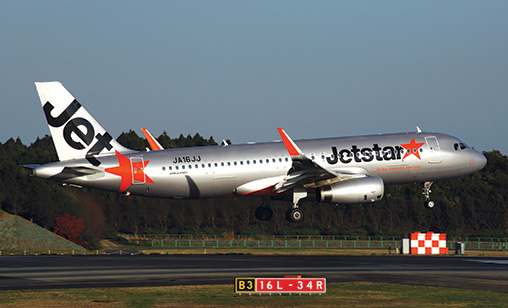News Backgrounder
Jetstar code share model fuels group’s growth
The Jetstar Group’s model of code sharing with several full service global carriers has become essential to the success of its subsidiaries as well as Qantas regional international operations.
July 1st 2017
Chief executive of Australia’s Jetstar Group, Jayne Hrdlicka, is more than happy with the inroads the budget airline company is making to Asia. Jetstar Japan, part-owned by Japan Airlines, is increasing its share of passenger traffic. Read More » Singapore headquartered joint venture, Jetstar Asia, is performing well and Vietnam’s Jetstar Pacific, majority owned by Vietnam Airlines, expects bumper years ahead.
Speaking on the sidelines of the International Air Transport Association’s annual general meeting in Cancun last month, Hrdlicka said the LCC group’s unique code sharing strategy with full-service carriers such as Emirates Airline, Japan Airlines and American Airlines, as well as Qantas, was working well.
 |
| 'Our shareholders will be happy to see it develop in a positive direction and there’s a lot of opportunity for continued growth. We expect, over time, that the profit margins we enjoy in Australia we will see in other parts of the portfolio' |
“Code-sharing with full-service carriers is a very important part of the model. We not only carry a lot of Singaporeans, but a lot of Europeans, Australians and Americans flying into Singapore to reach Southeast Asia,” she said. “We have 24 code share and interline partnerships. We see that as an important part of the portfolio.”
The result: an unparalleled network that sees Qantas and carriers from around the world feeding passengers onto Jetstar flights in Asia, as well as traffic feed from Jetstar International’s B787s flying to Japan, Thailand and Vietnam.
Japan, where Jetstar has hubs at Tokyo Narita, Osaka and Nagoya, is in a really good place, Hrdlicka said. “We launched to Shanghai in January, which is an important milestone for us in opening the China market from Japan.
“Our international business flying out of Japan to the region, primarily to North Asia (with a 21 A320 fleet), is proving very popular. The domestic market in Japan is going from strength to strength.
“The low fare segment is still quite small, at just over seven per cent, but it is forecast to grow to about 30% of the Japanese market. We are the market leader with about 50% of market share. We believe we have a strong brand in a growing part of the market.”
Of Singapore, where Jetstar Asia operates 18 A320s, Hrdlicka was more circumspect. “Our business in Singapore is doing OK. It is very competitive. We have seen a bit of a surge in capacity coming out of Malaysia, Indonesia and Vietnam,” she said, and added the carrier was cautious about fleet expansion given the competitive environment. “We will continue to be very tough in deciding how we play in Singapore and SoutheastAsia,” she said.
If there is one Jetstar subsidiary of concern, it may be Jetstar Pacific, but Hrdlicka said she did not see the Vietnam-based LCC as a problem. “Vietnam is going to take some time to settle down. We have a competitive dynamic with one airline (Vietjet), which is growing at levels above underlying market growth.
“But it is a hugely attractive market for the region. There is high growth in Vietnam and we have a good position in the market. We operate a dual brand strategy with Vietnam Airlines.”
Hrdlicka said: “We don’t need to keep pace with some of the other players coming into the game from Malaysia and Indonesia. We will be disciplined and wait for the market to stabilize before we feel a need to grow.”
When that time comes, there will be plenty of capacity in the pipeline. Qantas ordered 110 A320s in 2011: 32 A320s and 78 A320neos, with scope to convert some of the aircraft to A321s.
China would continue to be a key focus for the LCC group. As well as its Japan-Shanghai launch last January, Jetstar has been flying B787s from Australia’s Gold Coast to Wuhan, Central China, in partnership with Chinese property and entertainment conglomerate, the Dalian Wanda Group.
 |
Head of Qantas International Gareth Evans, also speaking in Cancun, said China would overtake New Zealand as the biggest inbound market to Australia this year. With Jetstar, Qantas’ own flights into China and its strong relationships with China Eastern Airlines in Shanghai, China Southern Airlines in Guangzhou and Cathay Pacific Airways in Hong Kong, the airline is “the best placed carrier in terms of Chinese relationships of any airline in the world”, he said. “We have the building blocks to take advantage of opportunity in China.”
Qantas Group chief executive, Alan Joyce, said air freight into China was a growth sector for the airline group. “The fresh produce going to China from Australia is quite a significant amount. Recently, we did a deal to carry 50,000 litres of milk a week to China,” he said.
“Also, every Chinese visitor to Australia takes between two and three domestic trips in the country. Chinese travel to Tasmania, Melbourne, Sydney and Queensland’s Gold Coast. They are different from many other travelers. There is potential for that market to grow in the next decade at 10% annually. It’s fantastic for us, for both brands and for the freight business.”